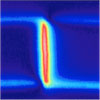Reference: J.-P. Tetienne, T. Hingant et al., Nat. Commun. 6, 6733 (2015).
Our recent study on the nature of magnetic domain walls in ultrathin ferromagnetic films has just appeared in Nature Communications.
In ultrathin ferromagnetic films with perpendicular anisotropy, such as Ta/CoFeB (1 nm)/MgO and Pt/Co (0.6 nm)/AlOx, it has been suggested that the presence of an interfacial chiral interaction of the Dzyaloshinskii-Moriya form, arising from the strong spin-orbit interaction in the “heavy metal” underlayer (Ta, Pt), could have a significant impact on the spin structure of the domain walls in such films. In particular, a sufficiently strong Dzyaloshinskii-Moriya interaction can favour Néel domain wall states over the Bloch states expected for such films. By using a novel scanning magnetometry method based on a single nitrogen-vacancy defect in a diamond nanocrystal, my colleagues at the Laboratoire Aimé Cotton in Orsay have shown unequivocally that the Dzyaloshinskii-Moriya interaction is large enough to promote Néel walls in Pt/Co (0.6 nm)/AlOx, while no signature of this interaction is present in Ta/CoFeB (1 nm)/MgO.
This finding has some important consequences on possible applications involving magnetic domain walls, such as racetrack memories, since current-driven spin torques like the spin Hall effect influence Bloch and Néel walls differently. Moreover, the presence of a strong Dzyaloshinskii-Moriya interaction in Pt/Co (0.6 nm)/AlOx suggests that such material structures could be promising for harbouring exotic chiral spin structures such as skyrmions.

One thought to “The nature of domain walls in ultrathin ferromagnets revealed by scanning nanomagnetometry”
Comments are closed.